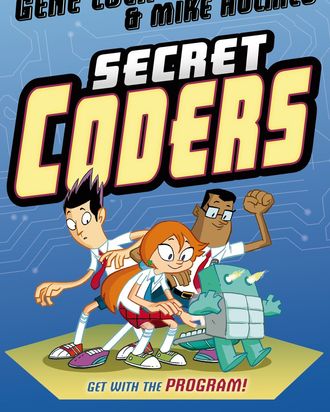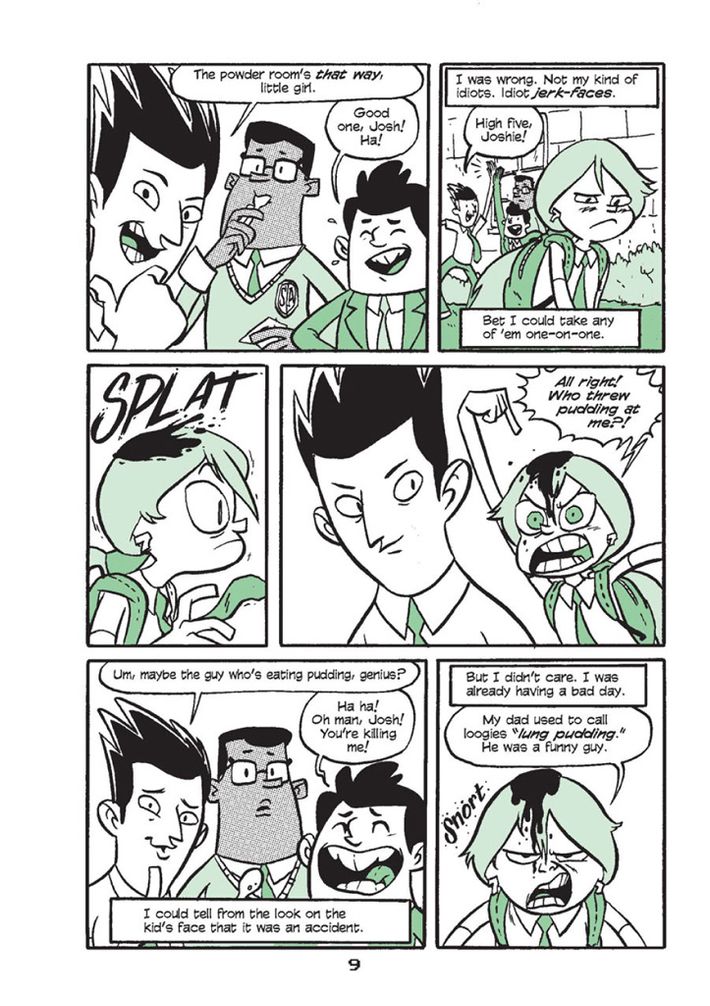
Comics creator Gene Luen Yang was just selected as one of the recipients of the MacArthur Foundation’s so-called “Genius Grants.” In light of the news, we’re republishing our December 2015 interview with Yang below. In a new email interview yesterday, he recalled finding out about the award about three weeks ago: “I got a call from the MacArthur Foundation in the morning, just as I was pulling out of my driveway to go to my local Panera Bread to work on a script,” he said. “I eventually made it to Panera, but didn’t get much work done.” He sees his selection as a victory for the comics medium. “I’m the third cartoonist to receive a fellowship. The amazing Ben Katchor and the amazing Alison Bechdel were ahead of me. I will certainly not be the last. I think it’s time to say that comics are legitimate, period. Graphic Novels have received top literary prizes, including Newbery Honors, Caldecott Honors, and a Pulitzer Prize. If you’re still turning your nose up at them, you are definitely in the minority.”
In his current life, Gene Luen Yang is best known as a writer and cartoonist, crafting award-winning graphic novels like American Born Chinese and the two-volume Boxers & Saints, landmark works that have gone on to be taught in schools and considered for awards normally exclusive to prose fiction. Yang has also recently expanded into more traditional comic books, writing DC Entertainment’s flagship Superman series, as well as official comic-book sequels to the beloved animated series Avatar: The Last Airbender for Dark Horse comics.
But up until last summer, Yang lived a second life as a high-school teacher, primarily in the field of computer science — something he continues to advocate for through graphic novels like Secret Coders and organizing activities for movements like Hour of Code. He currently has an art exhibit hosted by the Society of Illustrators you can go check out — which made now as good a time as any to catch up with Yang and chat a little bit about the breadth of his work and what he’ll be doing next.
A lot of your work features mythology — even Superman, which just introduced a fight club for brawlers inspired by different deities.
I’ve always been interested in mythology. In American culture, for a large variety of historical reasons, we’ve largely been surrounded by European mythology — even in our comics. Thor is probably the most prominent mythological character in the Marvel universe, and in the DC universe, Wonder Woman is just surrounded by all these Greek gods. We don’t really hear about these gods from other cultures.
So I wanted to introduce them — I didn’t even really know any! I found Haemosu, who is the Korean god of the sun. The Crow stole the sun, so Haemosu had to go after him. I then found Apolaki and Malyari, who are the Filipino goddeses of the sun and moon — I really wanted sun gods in there because Superman is a sun-based hero, so I thought he would fit, and that there were some interesting things to play with there.
Where does your interest in folklore stem from?
I don’t know! I grew up in an immigrant household, both my parents loved telling stories, but my mom especially told me a lot of stories that she grew up with, a lot of Chinese mythology — a lot of Monkey King.
They have these different theories about how a lot of what surrounds us in popular culture in America is rooted in myth, like Star Wars and superhero comics, which are all rooted in these mythological archetypes — and I think there’s something to that. As a geek growing up with Star Wars and superhero comics, when I learn about mythology, I feel something familiar about it.
Your work uses these icons and figures to tackle issues of racial identity. Is that something you’ve grappled with in your own life?
I think all of us go through a period of our lives where we want to distance ourselves from whatever it is that makes us different from the majority. For immigrant’s kids, that’s largely the culture of our parents that we want to escape from. Everybody wants to get away from their parents when they’re teenagers, but there’s this weird added component for immigrant’s kids where you don’t just want to get away from your parents, but you just want to get away from this entire culture, this entire piece of the world you just want to distance yourself from. That was something I really had to work through as I got older.

Is some of your work about reconnecting with that, then?
I think so, yeah! As I’ve gotten older, I’ve realized, I’m definitely an Asian-American, I’m definitely a Chinese-American. I visited China for the first time as an adult — I actually took a group of my students and it was super fun, but it was also really strange for me because I was experiencing things that I felt should’ve been familiar, but I only knew through echoes.
That’s when I realized — I’m pretty American! Having grown up here, American ways of thinking and looking at the world have embedded themselves into who I am. At the same time, I think that America is this collection of subcultures, and there’s not one monolithic culture. So the piece of America that I fit in is really the Asian-American piece. Or there’s a blend. You’re informed by both, Asian culture and American culture.
How do you take that approach to books like Avatar: The Last Airbender or Superman?
Well, Avatar, compared to Superman, has a very short history. It’s only been around for a few years, and the creators are still involved in the comic. So when I approach that, I just want to stay true to the voice of the show, and I also want to explore topics that the show explored that are also interesting to me. There’s a lot of overlap between my own personal interests and that show, which is why I loved it so much.
Superman is a little bit harder. Superman, because he’s an older character, because he’s gone through so many different incarnations — he means different things to different people. I feel like he gets redefined over and over again. For me, my connection to Superman is that he’s an immigrant. He’s an immigrant who can pass. He’s someone from another culture that could pass for mainstream. And that gives him this really unusual dynamic. I’m hoping that comes out in my run.
Your work on Boxers & Saints is currently being exhibited by the Society of Illustrators at the Museum of Comic and Cartoon art. It’s a pretty empathetic work about an ugly period of history — looking back, do you feel you accomplished what you were trying to achieve?
A lot of my stuff is about exorcising a demon. The way I got interested in the Boxer Rebellion was, in the year 2000, Pope John Paul II canonized this group of Chinese Catholic Saints. I grew up in this Chinese Catholic community, so my home church, they just freaked out about it. They had all these special celebrations and masses. That’s what got me looking into the lives of these saints, these newly canonized saints — and a lot of them were martyred during the Boxer Rebellion.
The more I read about the Boxer Rebellion, the more I felt like there was something about this tension between East and West, or between these different ways of viewing the world, and creating their own identity, and they just resonated with me. I could get why the Boxers were so mad, and I could also get why the Chinese Christians wouldn’t give up on their beliefs even though their beliefs came from a foreign culture. Both of those were understandable. In the beginning, when I first decided I want to do something about the Boxer Rebellion, I wanted to find a hero, a protagonist. I would read one book and I’d feel closer to the boxers; I’d read another, I’d feel closer to their Chinese Christian enemies. So I couldn’t decide. It was like an expression of my own ambivalence, the two-book nature of that project.
In terms of whether or not it exorcised demons? I feel like I came away with a more informed ambivalence than I had going on. Sometimes you can’t read your way out of ambivalence.
Do you have another graphic novel in the works?
I’m working on my first nonfiction book. I followed a high-school basketball team out of Oakland for a season next year, they were trying to get the state championship, and that’ll be my next book. I went with them on a lot of their away games, and talked to a lot of the players and the coaches.
Are you a big basketball fan?
I was not. Growing up, I hated basketball, because I was not good at it. But then a couple things happened that got me into basketball: I have a son who’s 12 now, and when he was around 9 or 10, he started getting interested in basketball. Around the same time, Jeremy Lin hit the scene, and you know what he did around here.
Seeing the Jeremy Lin phenomenon, seeing my son get attached to basketball got me interested in how basketball and culture kind of interface. Because there’s a lot of crazy things that have happened in basketball — like when the NBA started, it was an all-white league; the Lakers had to be defeated by the Harlem Globetrotters for African-Americans to be considered. And that was this crazy historic game.
Basketball has a special place in the interface of cultures. Some of the few Americans that were ever able to go through the Iron Curtain at the height of Soviet Communism were all basketball players, they were basically the Harlem Globetrotters. They were invited in, nobody else was. And then the same with North Korea right now — Dennis Rodman is probably the American that has had the most influence in that country. It’s weird!

